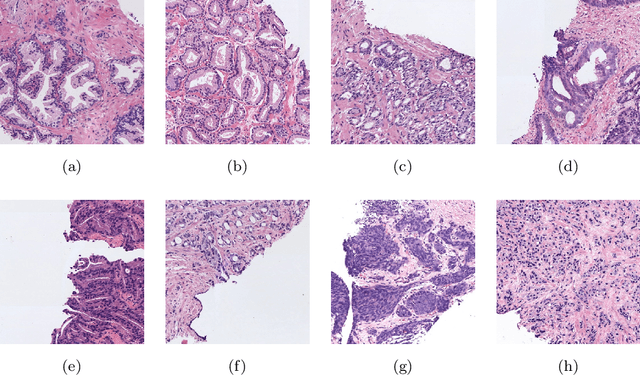María A. Sales
Going Deeper through the Gleason Scoring Scale: An Automatic end-to-end System for Histology Prostate Grading and Cribriform Pattern Detection
May 21, 2021



Abstract:The Gleason scoring system is the primary diagnostic and prognostic tool for prostate cancer. In recent years, with the development of digitisation devices, the use of computer vision techniques for the analysis of biopsies has increased. However, to the best of the authors' knowledge, the development of algorithms to automatically detect individual cribriform patterns belonging to Gleason grade 4 has not yet been studied in the literature. The objective of the work presented in this paper is to develop a deep-learning-based system able to support pathologists in the daily analysis of prostate biopsies. The methodological core of this work is a patch-wise predictive model based on convolutional neural networks able to determine the presence of cancerous patterns. In particular, we train from scratch a simple self-design architecture. The cribriform pattern is detected by retraining the set of filters of the last convolutional layer in the network. From the reconstructed prediction map, we compute the percentage of each Gleason grade in the tissue to feed a multi-layer perceptron which provides a biopsy-level score.mIn our SICAPv2 database, composed of 182 annotated whole slide images, we obtained a Cohen's quadratic kappa of 0.77 in the test set for the patch-level Gleason grading with the proposed architecture trained from scratch. Our results outperform previous ones reported in the literature. Furthermore, this model reaches the level of fine-tuned state-of-the-art architectures in a patient-based four groups cross validation. In the cribriform pattern detection task, we obtained an area under ROC curve of 0.82. Regarding the biopsy Gleason scoring, we achieved a quadratic Cohen's Kappa of 0.81 in the test subset. Shallow CNN architectures trained from scratch outperform current state-of-the-art methods for Gleason grades classification.
 Add to Chrome
Add to Chrome Add to Firefox
Add to Firefox Add to Edge
Add to Edge